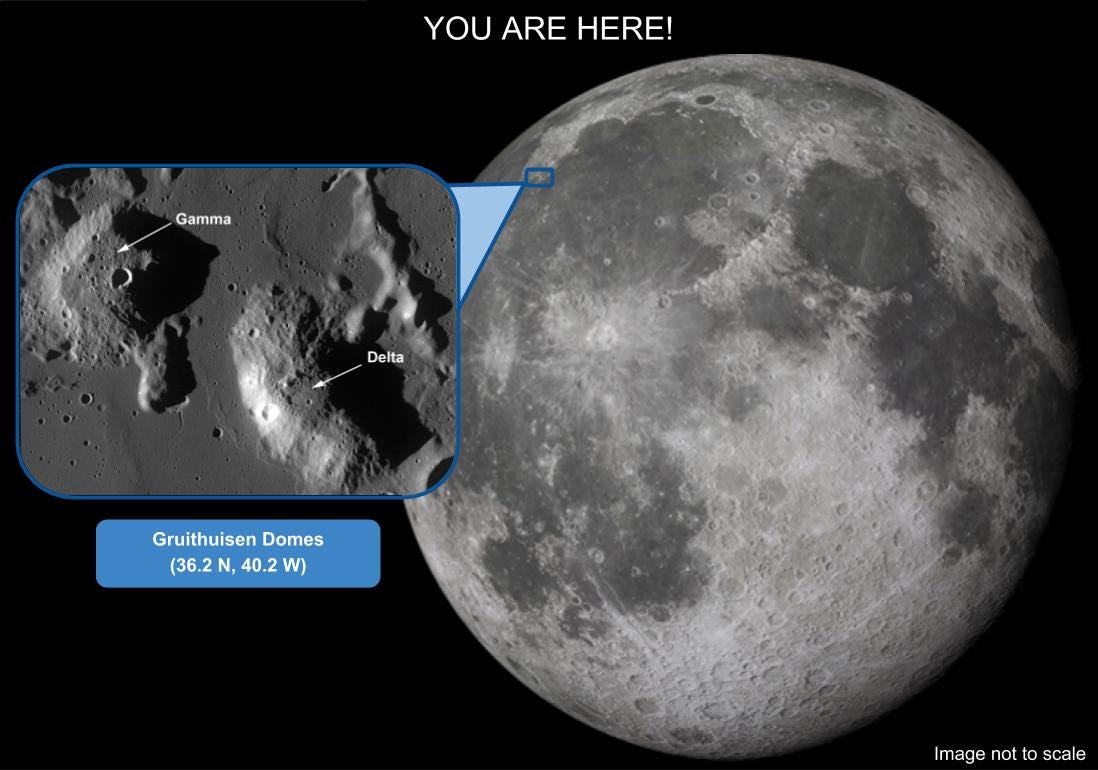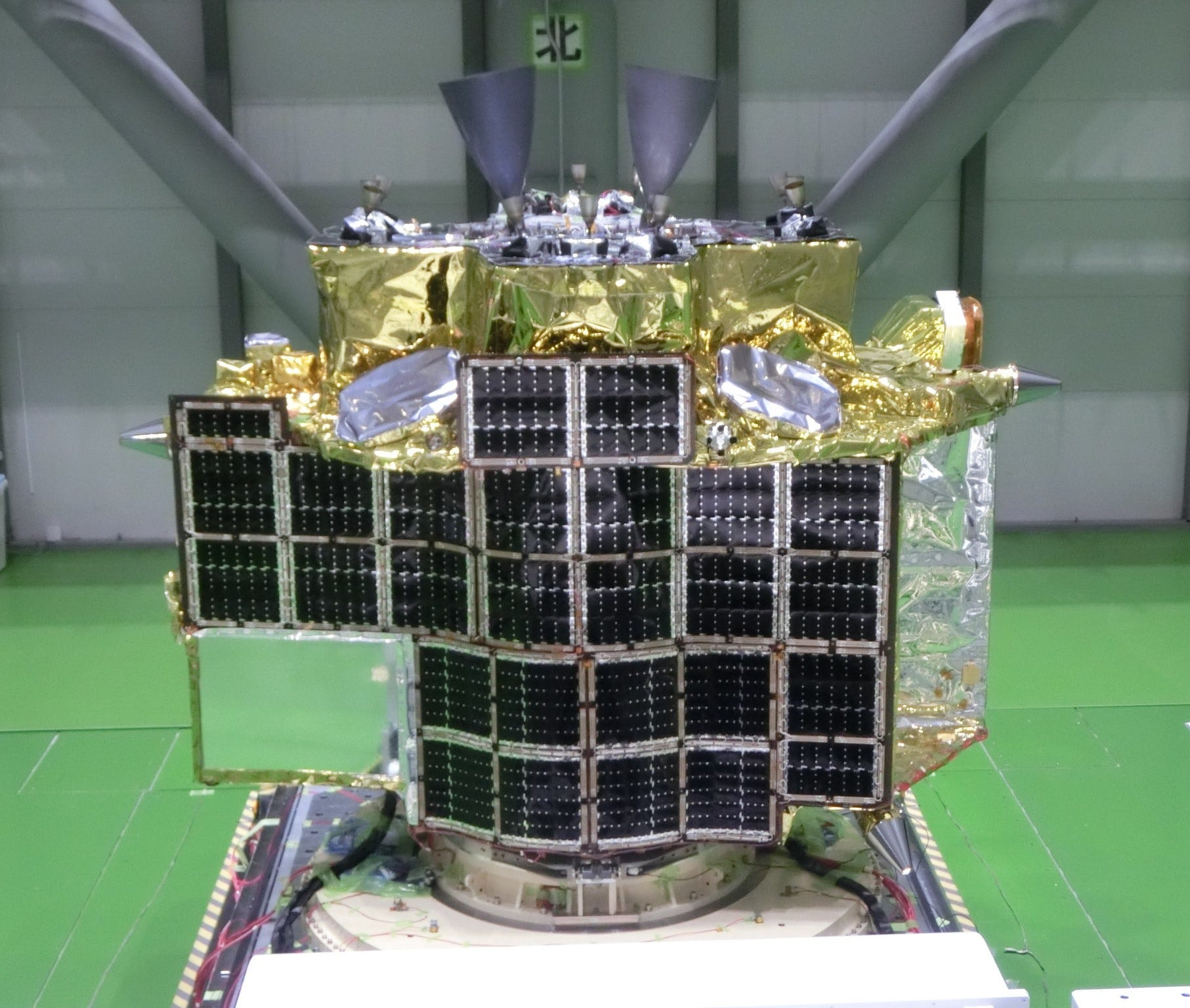Moon Monday #80: New spacesuits for Moonwalking, a volcanic visit, and updates from around the globe
The first Artemis astronauts to land on the Moon will wear privately developed spacesuits
After requesting proposals from U.S. companies in October last year, NASA has selected Axiom Space and Collins Aerospace to provide advanced and highly flexible spacesuits and associated services for future astronauts on the Moon as well as the International Space Station (ISS). Collins, who designed the Apollo suits, and Axiom notably beat out over 40 competitors, including SpaceX, Blue Origin and Sierra Space. NASA itself is dropping the development of its in-house xEMU suits in favor of the new proposals.

This move sees NASA double down on its “commercial” model bet to sustain lunar exploration, following decisions to purchase, rather than build, robotic and crewed lunar landers after success with equivalent ISS flights. This has implications for the process of developing and providing spacesuits.
The selected companies will bid to provide spacesuits for future Artemis missions, starting with the very first crewed landing with Artemis III currently being targeted for a 2025 launch. Additional vendors might get on the bidding list in the future via an on-ramp option, just like how NASA’s CLPS program to send payloads on commercial lunar landers added 5 vendors in a later phase, which notably included SpaceX, Blue Origin and Sierra Space.
NASA only defined the technical and safety standards for the spacesuits but won’t control how they’re met so as to encourage innovation in design, development, and production. That being said, NASA is making available all of its research on the in-house xEMU suits to accelerate development of the new suits while reducing risk. Here are some notable NASA requirements for the lunar spacesuits.
Support six two-person spacewalks on the Moon during initial Artemis missions. After astronauts come back from spacewalks, the suits should release less than 100 grams of notorious lunar dust into the cabin to keep things safe.
Support more and longer duration spacewalks on latter Artemis missions focusing on sustaining human presence on the Moon.
The most interesting part (for me anyway): NASA wants astronauts to venture inside the scientifically-valuable permanently shadowed regions on the Moon’s south pole. The spacesuits therefore must let astronauts enter such regions, where temperatures are well below -180 degrees Celsius, and function nominally for at least 2 hours.
The companies are investing their own money too to develop the suits, and they must find customers other than NASA to convert the technologies built into an actual commercial business. NASA wouldn’t state the exact funding the agency is providing to Axiom and Collins but said the combined value of all service purchases through 2034 will be no more than $3.5 billion. As usual, Jeff Foust has detailed reporting on the matter. Note though that the U.S. Presidential FY 2023 NASA budget request released in March asks for $276 million instead of the previous $100 million to accelerate development of lunar spacesuits, crewed rovers and other mobility systems.
Aside: The official NASA webpage for this advanced spacesuits program has a cool URL slug: nasa.gov/suitup
NASA to explore a unique volcanic dome on our Moon
NASA’s CLPS program to send science instruments to the Moon on commercial landers continues its enhanced science phase under the young PRISM initiative. After selecting science instruments to be launched in 2024 on missions to a lunar swirl and the Schrödinger crater, NASA has now selected two more instrument suites for launches in 2026.
The first selection is the Lunar Vulkan Imaging and Spectroscopy Explorer (Lunar-VISE), comprising two instruments on the lander and three on the CLPS-vendor-provided rover. Lunar-VISE will explore the summit of one of the over 15-kilometer wide Gruithuisen volcanic domes and analyze its lunar soil. The mission will greatly expand our knowledge of the Moon’s volcanic past and its early makeup because the Gruithuisen domes formed from thicker flows of rare silicic materials instead of the thin flows of basalt most common on the Moon.

The second selection is similar to the BioSentinel CubeSat mission launching for solar orbit on Artemis I this year. Both teams of researchers want to see the effects of deep space radiation on yeast, chosen specifically because their cells and humans cells share similar DNA damage and repair mechanisms. Earth-bound research can’t fully simulate the unique radiation environment of deep space so these missions will provide us new insights on the deep space radiation effects on biological life as NASA seeks to establish long-term presence on the Moon.
NASA will soon start the bidding process to select the commercial vendors providing the lunar touchdown for these two CLPS flights.
More on Chang’e 7
China will launch the Chang’e 7 mission in 2024 or 2025. It will consist of an orbiter, a relay satellite, and a lander. The lander will likely deploy a rover and a hopper (here’s a candidate six-legged design) to map resources in permanently shadowed areas near its landed region on the Moon’s south pole. Scientists have begun assessing candidate landing sites for the mission, which much like the case of NASA’s VIPER rover will likely be near small permanently shadowed craters less than a kilometer across.
Data from Chang’e 7, along with some of the upcoming Russian Luna missions, will help select a suitable site for the joint Sino-Russian long-term scientific base on the Moon’s south pole called the International Lunar Research Station.
Moon-tech flowing back to Earth
Last year, Astrobotic successfully field-tested their NASA-contracted laser mapping and navigation system with a drone that 3D-mapped part of an Alaskan glacier in real time. This technology will enable future spacecraft to autonomously navigate relative to any terrain they encounter, identify potential hazards, and select and touchdown on safe landing sites. This is very useful for landing in and around dark areas and rocky terrain as well as on icy moons in the outer solar system like Europa or Enceladus. This research was based on Astrobotic’s hazard detection and avoidance work for its CLPS mission to land NASA’s VIPER rover on the Moon’s south pole in 2023.
Now Astrobotic has won NASA-funding worth $1.5 million, under two Small Business Innovation Research (SBIR) contracts, to further advance said technologies through 2024 for space qualification. NASA considers the ability to work in totally dark and foreign environments useful for satellite servicing and refueling in Earth orbit. If future funding allows Astrobotic to build a flight-ready system, there would be a test flight on a CubeSat or from onboard the ISS.
Thank you Epsilon3 for sponsoring this week’s Moon Monday.
More Moon
JAXA shared an image of the flight model of its compact SLIM lander, which will launch by March 2023 to demonstrate pinpoint lunar touchdown (~100-meter accuracy) with such a low mass spacecraft. Aside: JAXA has a cool, jazzy website for the mission, the kind I haven’t seen in western outreach.

Credit: JAXA NASA says the CAPSTONE spacecraft, built by Advanced Space, will now launch on its Rocket Lab Electron booster no earlier than June 13. The launch period extends until June 22. The mission intends to prove the feasibility of the unique fuel-saving elliptical lunar orbit that the NASA-led Gateway station will be in later in the decade.
In a public contest held earlier this year, the South Korean space agency has officially named its KPLO lunar orbiter mission as Danuri, a blend of the Korean words “Moon” and “enjoy”. Launching this August, the Danuri mission will show us new views of the Moon’s surface and provide critical information about the lunar polar terrain and its water to help plan future crewed and robotic missions.
Lunar Outpost, the U.S. company building several classes of Moon rovers—whose activities I summarized in the previous Moon Monday—has established an office in Europe at Luxembourg. This EU office, funded by the Luxembourg government through an ESA Contract, will focus on developing thermal technologies to enable their rovers to survive the frigid lunar night and endure similarly harsh environments in our solar system. It’s notable that another lunar-centered company ispace inc. also has an EU presence, and at Luxembourg. I covered their lunar activities in Moon Monday #76.
What we know about India's Chandrayaan 3 Moon landing mission
